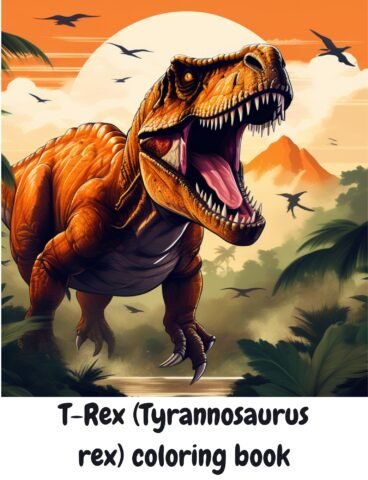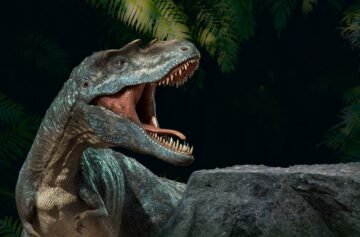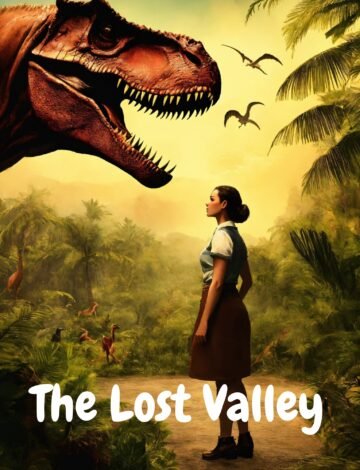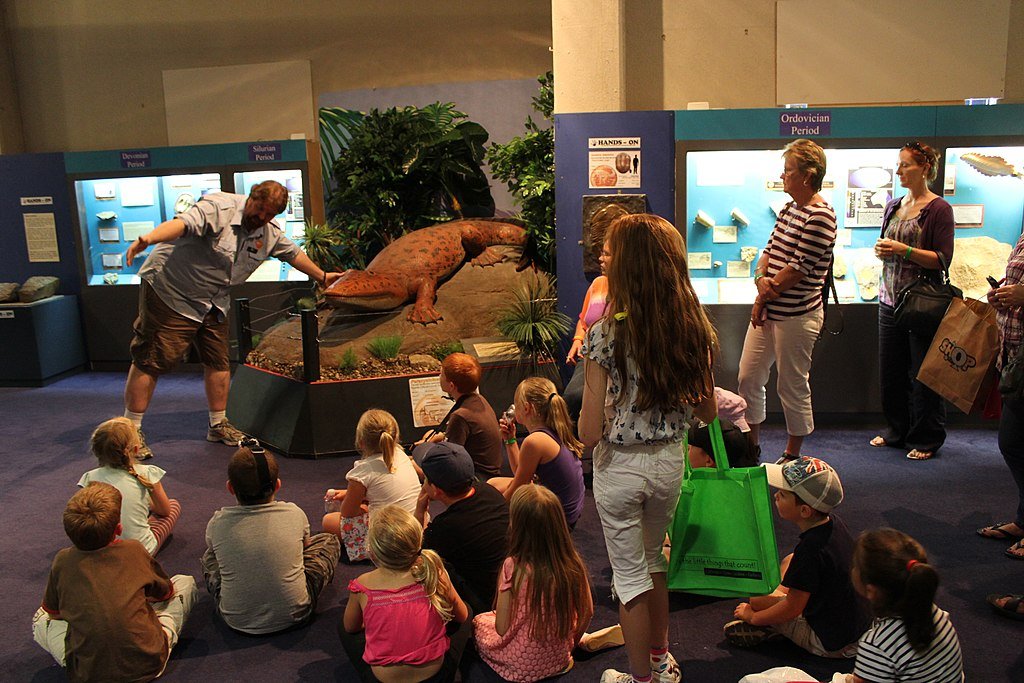Tyrannosaurus Rex Kids Guide
Tyrannosaurus Rex Kids Guide: Intro
 Approximately 66 to 68 million years ago, a fearsome carnivore roamed the lush, forested valleys of what is now western North America and Asia. This formidable beast, known as the Tyrannosaurus Rex, or “Tyrant Lizard King,” reigned supreme as a top predator, striking terror into the hearts of even the mightiest of its contemporaries.
Approximately 66 to 68 million years ago, a fearsome carnivore roamed the lush, forested valleys of what is now western North America and Asia. This formidable beast, known as the Tyrannosaurus Rex, or “Tyrant Lizard King,” reigned supreme as a top predator, striking terror into the hearts of even the mightiest of its contemporaries.
With its massive body, towering at over 12 meters (40 feet) in length and weighing up to 9 tons, the T-Rex was a true juggernaut. Its skull, measuring a staggering 1.5 meters (5 feet) in length and weighing a colossal 600 pounds, housed a deadly arsenal of jagged teeth, each measuring up to 30 centimetres (12 inches) in length – longer than a standard ruler!
Tyrannosaurus Rex Kids Guide: A Formidable Hunter or a Cunning Scavenger?
Dinosaur experts have long debated the hunting strategies of the T-Rex, with two primary theories emerging. Some argue that the T-Rex was an active predator, using its acute binocular vision, powerful jaws, and incredible speed to chase down and overpower its prey. Others contend that its massive size and bulk made it better suited as a scavenger, relying on its enhanced sense of smell to locate and consume already deceased animals.
Proponents of the predator theory point to the T-Rex’s well-protected skull, capable of withstanding the impact of a struggle with large prey, and its forward-facing eyes, which would have provided excellent depth perception for hunting. Additionally, its ability to sprint at speeds of up to 32 kilometres per hour (20 miles per hour) over short distances suggests it could have pursued and ambushed its quarry with relative ease.
On the other hand, those who favour the scavenger idea highlight the T-Rex’s small forelimbs, which may have hindered its ability to grasp and subdue live prey effectively. Furthermore, its exceptionally large olfactory bulbs – brain regions responsible for processing smell – were well-developed, an adaptation commonly seen in modern scavengers like vultures.
A Ferocious Bite and Diverse Dining Habits
Regardless of its hunting strategies, the T-Rex was undoubtedly a formidable predator or scavenger, thanks to its incredible biting force. With jaws capable of exerting over 35,000 newtons of force – enough to crush an automobile – the T-Rex could effortlessly tear through the toughest of hides and bones.
While the specifics of its diet remain a topic of debate, paleontologists (Dinosaur experts) have uncovered tantalizing clues about the T-Rex’s dining habits. In 1998, a remarkable discovery was made – a fossilized coprolite (fossilized fecal matter) measuring 43 centimetres (17 inches) in length and weighing a staggering 7 kilograms (16 pounds). Remarkably, this poo sample contained an abundance of bone fragments, suggesting that the T-Rex employed a unique feeding strategy.
Rather than swallowing large chunks of prey whole, as previously theorized, the T-Rex appears to have chewed its food thoroughly before ingesting it. This adaptation may have allowed the T-Rex to extract more nutrients from its meals and potentially consume a wider variety of prey, including the formidable Triceratops and the duck-billed hadrosaurs.
Tyrannosaurus Rex Kids Guide: The Evolution of a Tyrant
 While the T-Rex may have been the undisputed king of the Late Dinosaurs, it wasn’t always the dominant predator in its lineage. In fact, the tyrannosaur family has a rich evolutionary history spanning over 100 million years, with the T-Rex emerging as the top predator relatively late in the game.
While the T-Rex may have been the undisputed king of the Late Dinosaurs, it wasn’t always the dominant predator in its lineage. In fact, the tyrannosaur family has a rich evolutionary history spanning over 100 million years, with the T-Rex emerging as the top predator relatively late in the game.
Early tyrannosaurs, such as the Dilong, which lived approximately 125 million years ago, were relatively small, measuring only around 1.5 meters (5 feet) in length and weighing a mere 11 pounds. These diminutive predators coexisted with larger, more formidable carnivores like the allosaurs, ceratosaurs, and spinosaurs, which dominated the prehistoric food chain.
It wasn’t until the Late Cretaceous period that the tyrannosaurs began to evolve into the colossal predators we recognize today. The T-Rex, which first appeared around 68 million years ago, was the culmination of this evolutionary journey, surpassing its predecessors in size, strength, and ferocity.
The Reign of the Tyrant Lizard King
Despite its fearsome reputation, the T-Rex’s reign as the “Tyrant Lizard King” was relatively short-lived. Approximately 66 million years ago, a catastrophic event occurred – a massive asteroid, estimated to be around 10 kilometres (6 miles) in diameter, collided with Earth, triggering a series of environmental disasters that ultimately led to the extinction of the dinosaurs, including the mighty T-Rex.
While the T-Rex may no longer roam the Earth, its legacy lives on, captivating the imaginations of scientists and children alike. From its towering stature and bone-crushing jaws to its enigmatic hunting strategies and evolutionary journey, the T-Rex remains one of the most fascinating and iconic creatures to have ever walked the planet.
Tyrannosaurus Rex Kids Guide: Fossil Discoveries and the Tale of “Sue”
Our understanding of the T-Rex has been greatly enhanced by the discovery of numerous fossils, each shedding light on the anatomy, behaviour, and evolution of this remarkable creature. One of the most significant finds was the discovery of “Sue,” a remarkably complete T-Rex skeleton unearthed in the Black Hills of South Dakota in 1990.
Named after its discoverer, Sue Hendrickson, this exceptional fossil specimen is approximately 85% complete, providing an unprecedented glimpse into the anatomy of the T-Rex. Measuring an impressive 13 meters (42 feet) in length, Sue’s skeleton has become a valuable resource for paleontologists worldwide, allowing them to study the intricate details of the T-Rex’s skeletal structure and musculature.
In a remarkable display of scientific enthusiasm and dedication, the Field Museum of Natural History in Chicago acquired Sue’s fossil in 1997 for a staggering $7.6 million, making it the most expensive dinosaur skeleton ever purchased at the time. This investment has paid dividends, as Sue continues to captivate and educate visitors from around the globe, offering a tangible connection to the prehistoric world of the mighty T-Rex.
Anatomy and Physical Characteristics
The T-Rex’s imposing stature and formidable appearance were the result of a unique combination of physical characteristics that set it apart from other dinosaurs. Let’s delve into the key anatomical features that made this apex predator so remarkable.
Massive Skull and Powerful Jaws
 One of the most striking features of the T-Rex was its massive skull, which could measure up to 1.5 meters (5 feet) in length. This colossal cranium housed a formidable array of serrated, banana-shaped teeth, each measuring up to 30 centimetres (12 inches) in length, including the root.
One of the most striking features of the T-Rex was its massive skull, which could measure up to 1.5 meters (5 feet) in length. This colossal cranium housed a formidable array of serrated, banana-shaped teeth, each measuring up to 30 centimetres (12 inches) in length, including the root.
The jaws of the T-Rex were incredibly powerful, capable of exerting a bite force more than enough to crush the bones of its prey with ease. This incredible biting power was made possible by the T-Rex’s strong jaw muscles and a unique hinged jaw mechanism that allowed it to open its mouth exceptionally wide, up to 1 meter (3 feet) in some cases.
Binocular Vision and Enhanced Senses
While the T-Rex’s massive size and powerful jaws were undoubtedly its most intimidating features, its senses were also highly developed, contributing to its success as a formidable predator or scavenger.
The positioning of the T-Rex’s eyes allowed for binocular vision, providing it with excellent depth perception – a crucial advantage for hunting or locating carrion from a distance. Additionally, the T-Rex’s large olfactory bulbs suggest that it possessed an acute sense of smell, enabling it to detect the scent of potential prey or carcasses from miles away.
Robust Skeletal Structure and Powerful Legs
The T-Rex’s skeletal structure was designed for strength and power, with a robust build that could support its immense weight and withstand the rigors of hunting or scavenging.
Its hind legs, measuring approximately 3 meters (10 feet) in length, were incredibly muscular and ended in three forward-pointing toes, each equipped with sharp claws. These powerful legs enabled the T-Rex to move swiftly over short distances, with some estimates suggesting it could reach speeds of up to 32 kilometres per hour (20 miles per hour) during bursts of acceleration.
In contrast, the T-Rex’s forelimbs were relatively small, measuring only around 75 centimetres (30 inches) in length and ending in two large claws. While the purpose of these diminutive arms has been a subject of debate among paleontologists, some theories suggest they may have evolved to prevent interference with the T-Rex’s powerful jaws during feeding or combat.
Counterbalancing Tail and Bipedal Stance

One of the most distinctive features of the T-Rex was its long, heavy tail, which could contain over 40 vertebrae. This tail served as a counterbalance, allowing the T-Rex to maintain its bipedal stance – a trait shared by all theropod dinosaurs.
By walking on its two powerful hind legs, the T-Rex could conserve energy and move more efficiently, a crucial advantage for an apex (top) predator or scavenger. Additionally, this upright posture may have allowed the T-Rex to survey its surroundings more effectively, aiding in the detection of potential prey or threats.
Growth and Development
Like all living creatures, the T-Rex underwent a remarkable transformation from a tiny hatchling to a towering adult. Understanding the growth and development of this iconic dinosaur sheds light on its life cycle and the strategies it employed to survive in the harsh Cretaceous environment.
Egg-laying and Nesting Behaviour
While direct evidence of T-Rex nesting behaviour is scarce, paleontologists have made inferences based on the nesting habits of other theropod dinosaurs. It is believed that the T-Rex, like its relatives, laid clutches of eggs in carefully constructed nests, likely made of vegetation and soil.
The number of eggs in a typical T-Rex clutch is unknown, but estimates range from a handful to over a dozen, based on the reproductive strategies of modern-day reptiles and birds. Once the eggs hatched, the T-Rex hatchlings would have been vulnerable and dependent on their parents for protection and nourishment.
Rapid Growth and Adolescence
One of the most remarkable aspects of the T-Rex’s growth and development was its rapid rate of maturation. While hatchlings were relatively small, weighing only a few pounds, they underwent a dramatic growth spurt during adolescence.
Around the age of 14, a T-Rex’s body size would increase rapidly, with some estimates suggesting it could gain up to 600 kilograms (1,300 pounds) per year over the next four years. This rapid growth was likely fuelled by a voracious appetite and a constant need for sustenance, as the young T-Rex prepared for the challenges of adulthood.
Adulthood and Longevity

Once a T-Rex reached adulthood, its growth rate would have slowed significantly, but its size and strength would have continued to increase gradually over time. Fully grown adult T-Rexs could measure up to 13 meters (42 feet) in length and weigh up to 9 tons – truly colossal proportions for a terrestrial predator.
While the exact lifespan of the T-Rex is unknown, paleontologists have speculated that these apex predators could have lived for several decades, potentially reaching ages of 30 years or more in some cases. This longevity would have allowed the T-Rex to accumulate vast hunting experience and knowledge, further enhancing its survival and reproductive success.
Tyrannosaurus Rex Kids Guide: Hunting Strategies and Behaviour
The debate surrounding the T-Rex’s hunting strategies and behaviour has captivated paleontologists for decades. Was it a relentless predator, actively pursuing and overpowering its prey, or a cunning scavenger, opportunistically feeding on the remains of other animals? Let’s explore the evidence and theories that have fuelled this ongoing scientific discussion.
The Predator Hypothesis
Proponents of the predator hypothesis argue that the T-Rex was a formidable hunter, well-equipped to actively pursue and take down even the largest and most formidable prey. Several lines of evidence support this theory:
- Binocular Vision: The T-Rex’s forward-facing eyes provided excellent depth perception, a crucial advantage for tracking and ambushing prey.
- Speed and Agility: While its top speed is debated, the T-Rex was likely capable of short bursts of speed, allowing it to close the distance on potential prey quickly.
- Powerful Jaws and Teeth: The T-Rex’s massive jaws and serrated teeth were well-suited for tearing through flesh and bone, enabling it to dispatch prey efficiently.
- Robust Skeletal Structure: The T-Rex’s sturdy skeletal structure, including its thick skull and powerful hind legs, could withstand the rigours of hunting and combat.
Proponents of the predator hypothesis suggest that the T-Rex may have employed ambush tactics, using its keen senses to detect prey and then launching surprise attacks from concealed positions. Some even speculate that T-Rexs may have hunted in packs, coordinating their efforts to bring down larger prey.
The Scavenger Hypothesis
On the other hand, the scavenger hypothesis proposes that the T-Rex primarily relied on scavenging for sustenance, opportunistically feeding on the carcasses of animals that had already died. Several factors lend credence to this theory:
- Small Forelimbs: The T-Rex’s diminutive forelimbs may have been ill-suited for grappling with live prey, making it difficult to subdue and kill larger animals.
- Enhanced Sense of Smell: The T-Rex’s large olfactory bulbs suggest it had an exceptional sense of smell, a trait commonly associated with modern-day scavengers like vultures.
- Massive Size and Bulk: The T-Rex’s immense size and bulk may have made it less agile and less capable of sustained pursuit, favouring a more opportunistic scavenging lifestyle.
Supporters of the scavenger hypothesis argue that the T-Rex’s massive size and strength would have made it adept at intimidating smaller predators and scavengers, allowing it to monopolize carcasses and secure a steady food supply without the risks associated with active hunting.
The Opportunistic Omnivore Theory
While the predator and scavenger hypotheses represent the two dominant theories, some paleontologists have proposed a middle ground – the opportunistic omnivore theory. According to this perspective, the T-Rex may have employed a flexible foraging strategy, actively hunting when opportunities arose but also opportunistically scavenging when carrion was available.
This adaptability would have allowed the T-Rex to take advantage of a wide range of food sources, increasing its chances of survival in the ever-changing Cretaceous environment. Additionally, the opportunistic omnivore theory could explain the T-Rex’s diverse physical traits, such as its powerful jaws and enhanced sense of smell, which would have been advantageous for both hunting and scavenging.
Ultimately, the debate surrounding the T-Rex’s hunting strategies and behaviour continues, with new fossil discoveries and analytical techniques constantly reshaping our understanding of this iconic dinosaur. As research progresses, we may uncover definitive evidence that resolves this longstanding mystery, or we may find that the T-Rex was a true generalist, capable of adapting its foraging strategies to suit its ever-changing environment.
Tyrannosaurus Rex Kids Guide: Extinction and Legacy

Despite its reign as the “Tyrant Lizard King,” the T-Rex’s dominance was ultimately cut short by a catastrophic event that forever altered the course of life on Earth. Approximately 66 million years ago, a massive asteroid, estimated to be around 10 kilometres (6 miles) in diameter, collided with the planet, triggering a series of environmental disasters that led to the extinction of the dinosaurs, including the mighty T-Rex.
The Impact and Its Aftermath
The asteroid impact, which occurred in what is now the Yucatán Peninsula in Mexico, unleashed a devastating amount of energy, equivalent to the detonation of millions of nuclear bombs. The immediate effects of the impact included widespread wildfires, tsunamis, and the release of vast quantities of dust and debris into the atmosphere.
As the dust and debris circulated in the upper atmosphere, it blocked out sunlight, causing a severe and prolonged global cooling event known as an “impact winter.” This drastic climate change disrupted food chains and ecosystems, leading to the gradual extinction of many plant and animal species, including the non-avian dinosaurs.
The Rise of Mammals
While the asteroid impact marked the end of the dinosaurs’ reign, it also paved the way for the emergence of a new group of animals – the mammals. With the dinosaurs out of the picture, mammals were able to diversify and occupy ecological niches that had previously been dominated by their reptilian predecessors.
Over millions of years, mammals evolved into a wide array of forms, ranging from the massive and mighty to the small and agile. Some of the most iconic and beloved animals we know today, such as elephants, lions, and primates, can trace their lineage back to the mammalian survivors of the mass extinction event that wiped out the dinosaurs.
Tyrannosaurus Rex Kids Guide: The Enduring Fascination with T-Rex
Despite its extinction millions of years ago, the T-Rex continues to captivate the imagination of people worldwide, from curious children to seasoned paleontologists. Its imposing stature, fearsome appearance, and the mystery surrounding its behaviour have made it a cultural icon, featured in countless books, movies, and museum exhibits.
Pop Culture Phenomenon
The T-Rex’s popularity in popular culture can be attributed, in part, to its starring role in the iconic “Jurassic Park” film franchise. The terrifying depiction of the T-Rex in these movies, combined with groundbreaking visual effects, brought the prehistoric predator to life in a way that had never been seen before.
Beyond the silver screen, the T-Rex has also made its mark in other areas of pop culture. From toys and games to cartoons and comic books, the “Tyrant Lizard King” has become a beloved and instantly recognizable figure, inspiring awe and wonder in generations of children and adults alike.
Tyrannosaurus Rex Kids Guide: Scientific Significance
While the T-Rex’s pop culture status is undeniable, its scientific significance should not be overlooked. The study of this iconic dinosaur has provided invaluable insights into the evolution of life on Earth, the dynamics of prehistoric ecosystems, and the processes that shaped our planet’s history.
Each new fossil discovery, whether a complete skeleton or a single tooth, offers paleontologists an opportunity to unravel the mysteries of the T-Rex’s anatomy, behaviour, and evolutionary journey. By piecing together these clues, scientists can gain a deeper understanding of the past and better prepare for the challenges of the future.
Inspiring Future Generations
Perhaps the most enduring legacy of the T-Rex is its ability to inspire and captivate the minds of young people. For countless children, the first encounter with this prehistoric predator ignites a lifelong passion for science, exploration, and discovery.
Through educational programs, museum exhibits, and interactive experiences, the T-Rex serves as a gateway to the fascinating world of paleontology, encouraging young minds to ask questions, seek answers, and pursue their curiosity about the natural world.
As we continue to unravel the mysteries of the T-Rex and the Cretaceous period in which it lived, its legacy will continue to inspire and educate generations to come, ensuring that the “Tyrant Lizard King” remains a beloved and iconic figure for years to come.
We hope you have enjoyed this Tyrannosaurus Rex Kids Guide.
COPYRIGHT: We allow you to download and print this page for your little ones, whether you are an Individual or a Business, PROVIDED you do not Remove this Copyright Notice. You cannot charge for this page, only give it away. This page is copyright www.DinosaurBooks.com.au – Our other websites for Children are at www.KidsStoryBooks.com.au and www.PersonalisedKidsVideos.com. Our Business Websites are at www.GoldCoastLocalBusinessWebsites.com.au and www.VideoMarketingServices.com.au – We look forward to doing business with you. Have a Great Day!